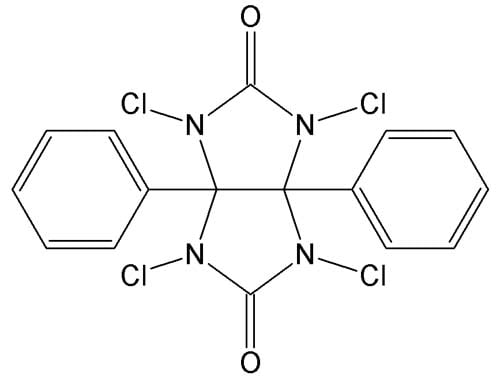1,3,4,6-tetrachloro-3α,6α-diphenylglycoluril (Chloroglycoluril), also known as Iodo-Gen®, is one of the best reagents used for iodination of proteins, hormones, antibodies, viruses, cell membranes, etc. This method was first developed by Fraker et al. This method of iodination with Iodo-Gen® is simple and inexpensive. Iodo-Gen® is water-insoluble and hence used in solid-phase iodination. Iodo-Gen® is used to incorporate radioactive iodine in aromatic amino acids like tyrosine. It iodinates proteins in oxidizing conditions, so there is no need for using excessive reducing agents that affects protein stability. The proteins are not directly subjected to oxidation in this method as the reagent sticks to the wall of the tube and protein is in solution. Either Iodo-Gen® is coated on the walls of glass vials or on polystyrene beads. Iodo-Gen® is dissolved in an organic solvent and the organic solvent is removed from the vial by using nitrogen. The Iodo-Gen® that sticks to the wall of the vial or beads later iodinates proteins in solution. Protein can be separated easily from unreacted reagent as Iodo-Gen® is water-insoluble.
The polymerase chain reaction is a widely used technique for amplification of DNA products for genetic studies, DNA fingerprinting, clinical diagnostics, forensics and many more. Non-specific amplification of PCR products and the formation of primer dimers are the major problems during a PCR reaction. The main reason is due to the mild activity of polymerases at low temperatures and the binding of primers at nonspecific sites. As a result, even before the start of PCR amplification non-specific gene products and primer dimers are formed. The yield of target DNA is reduced as the polymerase, nucleotides, and primers are consumed. Hot start PCR methods are used to avoid this problem.
Topics: Molecular Biology
Use of Chaperones in Recombinant Protein Expression
Proteins that form complexes tend to form aggregates during recombinant expression. So the best method is to co-express proteins with suitable partner protein. Chaperones are one of those proteins that help insoluble protein formation. Researchers observed the enhanced solubility of some proteins when co-expressed with chaperones. However, the choice of suitable chaperone for a particular protein is difficult to assume and only with trial and error methods one can achieve a soluble protein. Chaperones act as catalysts that prevent aggregation of nascent chains and unfolding aggregate proteins. Co-expression of recombinant proteins with chaperones help in improved solubility, enhanced specific activity and yield of target proteins.
Topics: Protein Purification
Using Western Transfer for Protein Detection: Some Commonly Used Methods
Topics: Western Blotting







